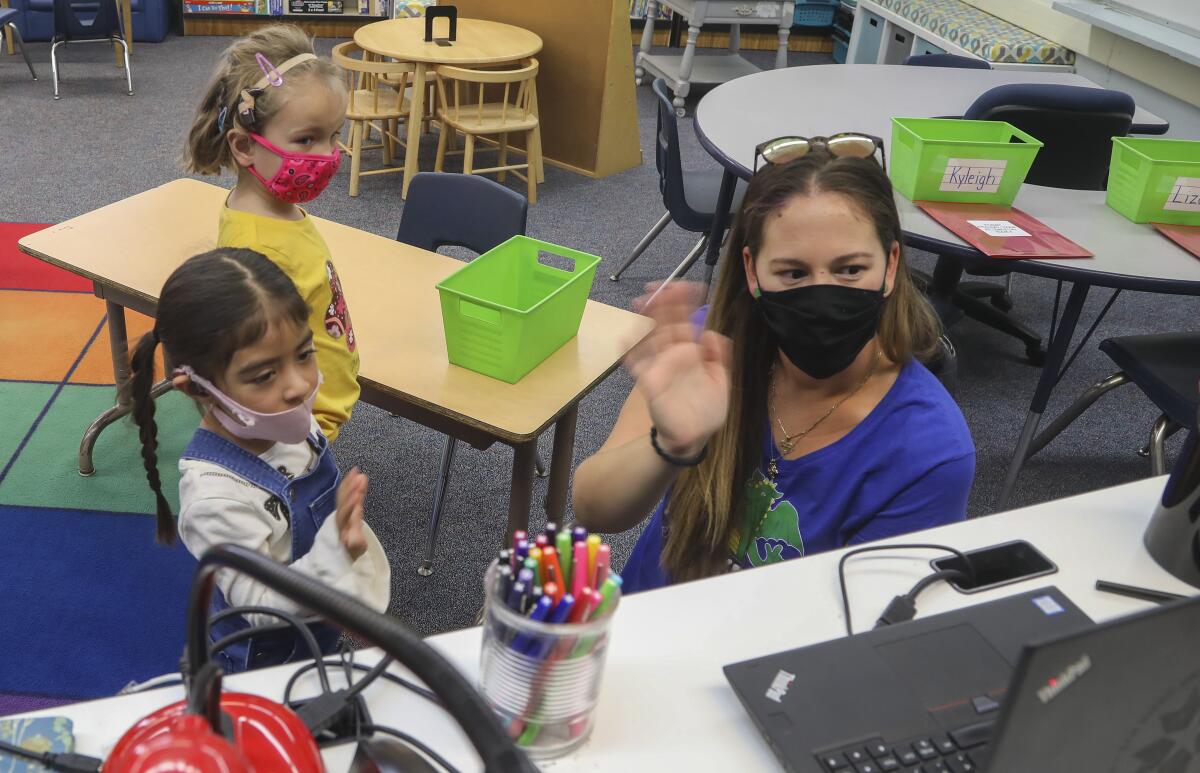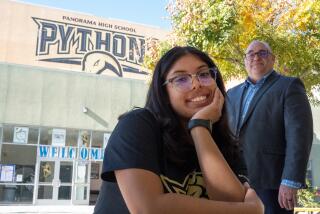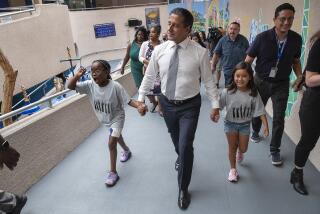Thousands of children could be back to school sooner under a new L.A. County waiver policy

- Share via
County officials have made it easier for elementary schools to reopen for their youngest students under waivers, dropping a requirement for schools to provide a letter of support from employee unions as part of the application, The Times has learned.
The decision streamlines the application process and could potentially reopen classrooms to thousands of children, but it’s likely to raise concerns among teachers and other employees about possible exposure to health risks.
The move — previewed by county Public Health Director Barbara Ferrer in two conference calls with school and school district leaders Thursday — came a day after county Supervisor Kathryn Barger announced that all schools in L.A. county are now allowed to bring on campus up to 25% of a school’s enrollment to serve students with special needs, especially students with disabilities or students who are learning English.
Combined, the two moves could potentially open the schoolhouse doors for hundreds of thousands of students — the county has about 1.5 million K-12 students. General operations for all students are not permitted because the county remains in the state’s worst, or purple, tier for reopening, which signifies widespread community transmission of the coronavirus. Under state guidelines, schools can reopen 14 days after the county moves the next tier, red.
The elementary waiver would apply to students in transitional kindergarten through second grade. Under state rules, the county could grant waivers allowing schools to operate through sixth grade, but health officials aren’t ready for that step.
Ferrer acknowledged that the requirement for letters of support from employee unions had made it difficult for some schools to apply for waivers.
The vast majority of waiver applications were coming from private schools, followed by charters, which are public schools but mostly nonunionized. Though county officials had planned to give priority to schools that serve a higher number of low-income students, the requirement for letters of support was apparently proving a hurdle.
In addition to dropping the union-support requirement, the county also will drop a similar requirement for letters of support from representative parent groups.
“We will now just require a consultation process with your stakeholders,” Ferrer said in a recording of one of her calls with education leaders.
Ferrer indicated that the formal announcement of the waiver revision could happen Friday.
As of Wednesday, the county had received waiver applications from 87 private schools, 18 charter schools and five traditional public schools. Four schools have been approved; all are private schools. An additional 30 applications are complete and undergoing final review. Officials have committed to trying to approve 30 applications per week.
“This is welcoming news to hundreds of thousands of families and kids,” Supt. Alex Cherniss of the Palos Verdes Peninsula Unified School District said. “The prior waiver system benefited families that can afford private and independent schools, from which over 90% of the waiver applications were submitted.”
Cherniss was among the public officials who had asked the county to revise its waiver rules.
L.A. schools Supt. Austin Beutner said last week that waivers, approved 30 schools at a time, are a poor fit for the massive school system and that he was focused instead on efforts such as building a tutoring program and getting campuses ready for the moment when all students would be returning — when it is safe to do so.
The district had no comment Thursday.
In a brief statement, a spokeswoman for United Teachers Los Angeles said the union intends to bargain the terms and conditions of its members’ return to campus. On social media Thursday, the union posted a news story about the closing of campuses in Boston because of a coronavirus surge.
Stephanie Yellin-Mednick, a school nurse and teachers union member who worked with the school district over protocols for coronavirus testing, tweeted her disapproval of the changes, saying that the negotiation process with unions ultimately benefited students.
Glendale Unified Supt. Vivian Ekchian said she’s interested in exploring waivers but would seek community input and direction from her school board at its Nov. 2 meeting. She added that many teachers have told her that they are ready to come back. She said she plans to keep working with the leadership of the Glendale teachers union to reach common ground.
Ekchian said the district also is working out plans for bringing back small groups of students with special needs around the beginning of November and would probably see how things go before stepping up from 10% of enrollment — the previous maximum — to the new ceiling of 25%.
“We truly believe in a gradual, careful, robust return that is taking all aspects of this experience into consideration,” Ekchian said.
Las Virgenes Unified is among the few districts to quickly submit a waiver application. Its teachers union was willing to provide a letter of support.
The four schools that have been issued waivers are Rabbi Jacob Pressman Academy of Temple Beth Am in Pico-Robertson, Los Encinos School in Encino, Holy Angels School in Arcadia and Kadima Day School in West Hills.
At these private schools the percentage of students who qualify for a free or reduced-price lunch ranges from 2% to 16%. By comparison, 69% of L.A. County students qualify because they are part of low-income families, according to 2019 data.
Los Encinos and Holy Angels have opted for staggered attendance and will offer hybrid and virtual options to families, according to their waiver applications. Pressman and Kadima will bring students back full time, although Kadima Head of School Steven Lorch said one to three students in every class will continue to learn remotely through Zoom.
Lorch said his staff began preparing to apply for a waiver in July, before L.A. county opened up its process. Kadima looked at what other counties were requiring and planned accordingly.
“We knew that while e-learning had gotten better and better, it would never be equal to in-person learning,” Lorch said. “There’s just so much that children, particularly young children, benefit from in person — the nonverbal cues, the warmth of the room itself, all of which is absent when you’re a bunch of disembodied faces on a screen.”
Kadima has installed an 8-foot-wide plexiglass shield in each classroom that separates the teaching area from the students — a “symbol to teachers that they need to think three times before they cross that barrier over to the student side,” Lorch said.
Times staff writer Julia Barajas contributed to this report.
More to Read
Sign up for Essential California
The most important California stories and recommendations in your inbox every morning.
You may occasionally receive promotional content from the Los Angeles Times.












